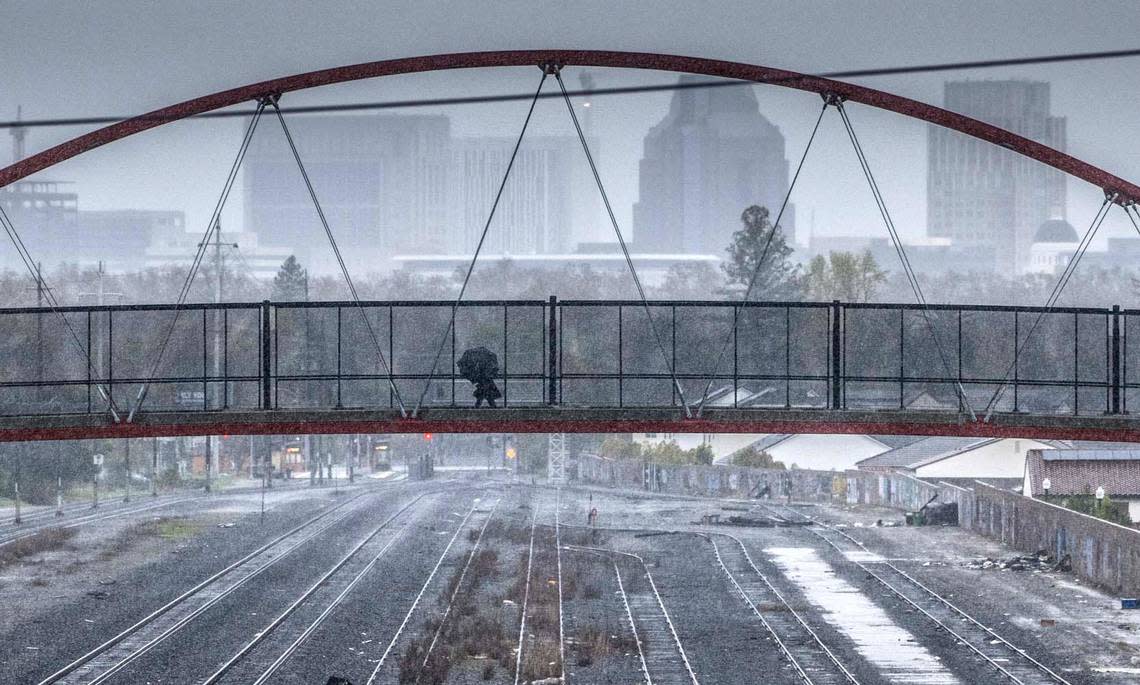Why is air quality so bad in Sacramento in the winter? Here’s what experts say

Why is air quality so bad in Sacramento during the winter months?
According to meteorologists and air quality experts, the reason has to do with the topographic position of California’s capital city.
Wood-burning stoves and fireplaces also play a part.
Why is air quality bad in Sacramento in the winter?
During the winter months, the Sacramento area experiences temperature inversion, which is a “layer in the atmosphere where temperature increases with height,” according to the National Weather Service.
This causes the cooler air to be near the earth’s surface and the warmer air to be on the top.
“Since warm air rises, air under the inversion cannot escape because it is cooler than farther aloft,” the Weather Service said. “Smoke and pollution get trapped.”
“Cooling will occur the most readily in low places” such as the Sacramento Valley, the Weather Service said.
“When the air is colder nearer to the ground and the air above it is warmer, then the air doesn’t get mixed or distributed,” said Emily Allshouse, associate communication and marketing specialist at the Sacramento Metropolitan? Air Quality Management District. “When there are not very much winds, winds cannot blow the pollution out of our general valley area. ”
The valley acts as a “big bowl,” Allhouse explained.
The temperature inversion traps bad air by “basically putting a lid on that bowl and not allowing the pollutants to be dispersed,” Allshouse said.
How is air quality measured?
Air quality is measured using the air quality index, also referred to as AQI.
It’s calculated daily unless there is an extreme condition, such as a wildfire, that causes it to be updated more often.
When air quality is stable, the U.S. Environmental Protection Agency uses 12-hour averages to calculate an AQI, UC Davis professor Qi Zhang told The Sacramento Bee in June.
Zhang teaches in the UC Davis Department of Environmental Toxicology and conducts research on air pollution.
During fire season, air quality is calculated in real time.
Zhang said ozone levels are calculated hourly and the amount of particulate matter with a diameter of 2.5 micrometers or smaller, known as PM 2.5, is calculated every three hours.
According to AirNow.com, which reports air quality using the official U.S. Air Quality Index, Sacramento’s air quality index was at a moderate level on Monday and Tuesday.
Wednesday’s AQI listed as good, the AirNow site said.
AirNow is a partnership of the U.S. Environmental Protection Agency, National Oceanic and Atmospheric Administration, National Park Service, NASA, Centers for Disease Control, and tribal state, and local air quality agencies
The AQI chart is broken into six colors: green, yellow, orange, red, purple and maroon.
Each color represents a range on the AQI chart from zero to 500, with zero being “satisfactory air quality” and 500 being “health warning and emergency conditions.”
Air quality is reported using the Air Quality Index (AQI). Do you know what these numbers and their corresponding levels mean? View the chart below to find out. To see the current air quality in your area, visit https://t.co/CVx9g8Hm1q pic.twitter.com/ntlmHoPXq7
— National Weather Service (@NWS) July 26, 2022
What’s the top contributor to bad air in the winter?
Particle pollution is often a result of fires, experts say.
An AirNow study discovered that “wildfires contribute 15 to 30% of atmospheric primary fine particulate matter emissions in the United States”.
During the winter months, wood burning contributes about 50% of air pollution, Allshouse said.
What is Check Before You Burn?
To combat air quality from becoming worse in the cooler months, the Air Quality Management District initiated the Check Before You Burn program in 2017.
The program restricts burning of firewood when pollution is about particle pollution is at or above PM 2.5.
The Check Before You Burn program kicks off annually in November and runs through the end of February.
Outdoor burning is restricted, and people are also limited in how they can use fireplaces, wood stoves, fireplace inserts and pellet stoves, Allshouse said.
When can I use my fireplace?
Check The Sac Metro Air District website for daily burn status during the winter months before using your fireplace.
Burn status is broken down into four categories:
Legal to burn: No restrictions are in place, and burning is allowed.
Burning discouraged: Refrain from burning
Stage 1: No burning is allowed unless you’re using an EPA-certified fireplace insert, stove or pellet stove that won’t emit visible smoke.
Stage 2: Burning is prohibited. This includes solid fuel, including wood, manufactured fire logs and pellets, in any device.
What do you want to know about life in Sacramento? Ask our service journalism team your top-of-mind questions in the module below or email servicejournalists@sacbee.com.

